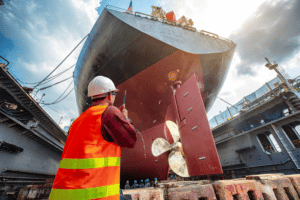Ladders and steps make it easy for marine workers to go from one deck of a vessel to another or to access high areas. However, ladders, steps and gangways are dangerous and account for many shipboard injuries and deaths. In fact, statistics show that hundreds of maritime workers suffer ladder and step accidents every year.
A vessel owner and/or maritime employer are obligated under general maritime law to ensure that workers are provided a seaworthy vessel and a safe working environment. Yet, many of these accidents are caused by negligence and careless planning.

Maritime Ladder and Step Accidents
According to a U.S. Navy safety report, falls from heights, which include falls from steps, ladders, and gangways, are a leading cause of fatalities in all industries. The average annual number of fatal fall-from-height accidents increased from 479 in 1992 to 607 in 2002. Though more than half of these deaths occurred in the construction industry, the tally includes many seamen and fishermen. The majority of ladder and step accidents and injuries typically occur due to:
- Poor maintenance
- Lack of safety training
- Design and structural flaws
- Assembly mistakes
Safety Standards For Steps and Ladders
Although maritime jobs entail some accepted risks, ship owners and employers have a legal obligation to provide their employees with a safe working environment. Federal agencies such as the Occupational Safety and Health Administration (OSHA) and worldwide industry organizations like the International Maritime Organization (IMO) oversee and enforce job safety regulations. Many of these regulations set global safety standards for ladders and steps on various types of ships.
For instance, the IMO specifies that access to a ship’s elevated passageways and vertical opening from the vessel’s bottom must be given via easily accessible passageways, ladders or treads. Treads must have lateral support for feet, while permanent ladders must be inclined at angles of less than 70 degrees. Exceptions are made for vertical ladders on vertical structures for inspection purposes. Steep ladders with acute angles are responsible for many injuries and deaths, both aboard ship and in shipyards and other port facilities.
Guidelines for Various Types of Ship Ladders and Steps
- No free-standing portable ladder should be over 5 meters in length
- Portable ladders must be of good construction, have adequate strength, and maintained properly.
- Portable ladders must be used at an angle of between 60 and 75 degrees from the horizontal.
- Accommodation ladders and gangways must be clearly marked with the maximum permitted angle of use and the maximum safe loading limit. This includes both the total of persons the gangway can accommodate and the total weight allowed. These limits must not be exceeded under any circumstance.
- Flights of ladders must not be longer than 9 meters in actual length, and appropriate resting platforms must be provided.
- Ladders and handrails must be made from steel or a material of equal strength and stiffness. They must also be secured to decks and superstructures by stays.
- Seamen should use all means of access to a ship, including ladders and steps, with care. Standard operating procedures must emphasize crew safety, including how to avoid dangerous practices such as carrying too much gear at once or using unsafe means of access.
- All ladders, steps, gangways and other access equipment must be well-built, made from sound materials, possess adequate strength, be free from any noticeable defect, properly maintained and inspected regularly.
- Ladders, steps and other access equipment must not be painted to hide cracks, corrosion, or any other defects.
The U.S. Coast Guard and OSHA are responsible for ensuring that U.S. maritime employers are provided with a safe working environment. Issues that may constitute an unsafe environment include:
- Unsafe shipboard procedures
- Disregard for OSHA maritime workplace safety standards
- Failure to stow, procure, or maintain ladders, steps, gangways
- Failure to properly store and maintain equipment
These failures can all result in serious injuries or deaths. These violations make maritime employers negligent if they were aware or should have been aware of any unsafe access equipment but did nothing to repair or replace it.
For more information on maritime industry safety and OSHA regulations, employers’ obligations, and workers’ rights, see OSHA’s Safety and Health Tips: Maritime Industry page.
Sources:
- https://www.osha.gov/pls/oshaweb/owadisp.show_document?p_table=STANDARDS&p_id=10237
- http://www.tsb.gc.ca/eng/rapports-reports/marine/1997/m97m0141/m97m0141.asp
- http://www.ilo.org/wcmsp5/groups/public/@ed_protect/@protrav/@safework/documents/normativeinstrument/wcms_107798.pdf
- https://www.osha.gov/dts/maritime/